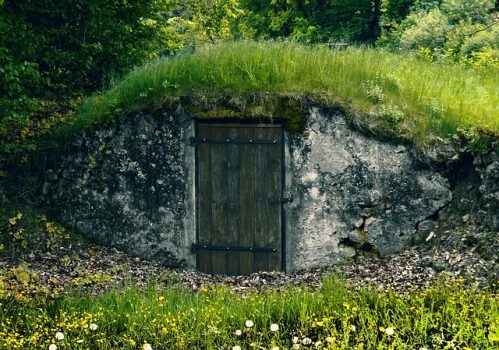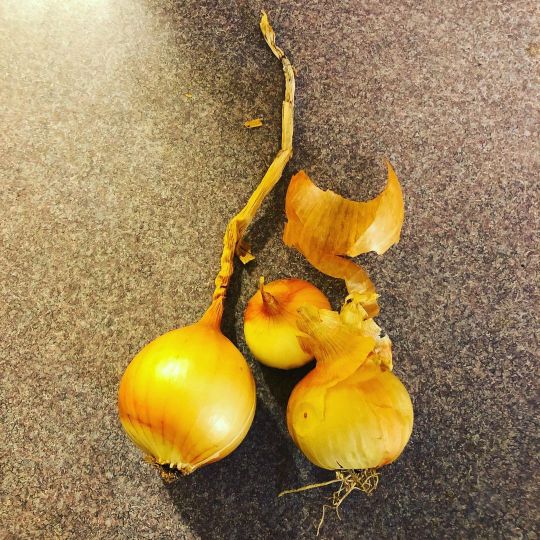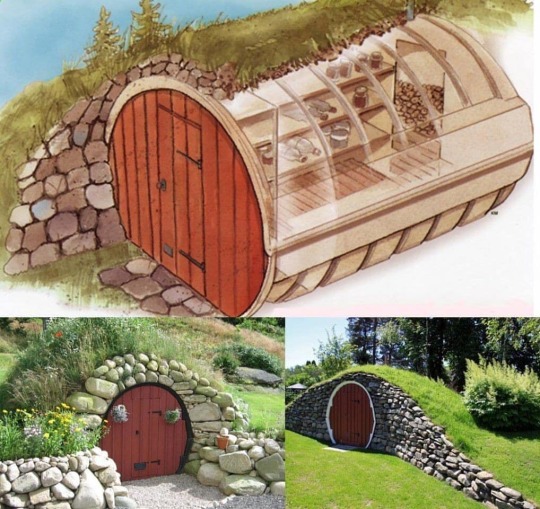#RootCellaring
Explore tagged Tumblr posts
Text
A Sermon for March 19th: The Garden as Legacy
A Sermon for March 19th: Sustaining the Future
Brothers and Sisters in the Atom, the act of growing and preserving food is an act of care—for ourselves, for our communities, and for the future. Just as we seek to preserve knowledge so that vital warnings and wisdom are not lost, so too must we preserve the means to sustain life. A well-tended garden, like a well-kept archive, is a gift to both the present and the generations to come.
The Garden as a Legacy
My own journey with gardening began with my grandfather, who learned from his parents—farmers who passed down their knowledge of the land. From them, I learned the value of tending to the earth, of patience in cultivation, and of the responsibility to sustain life. Later, I expanded this foundation through academic study, deepening my understanding of sustainable growing methods. I also learned the art of canning, ensuring that what is grown in times of abundance can sustain us in times of need. My great-grandparents, my grandfather, and myself are just three links in a chain that has stretched for thousands of years. Throughout history people have passed down knowledge of how to cultivate the land, how to store food for lean times, and how to adapt to changing conditions.
To plant a seed is to express faith in the future. To teach another how to grow and preserve food is to pass forward resilience, just as we pass forward knowledge of radiation’s unseen dangers. A garden does not only provide nourishment—it is a symbol of foresight, patience, and preparation.
The Importance of Food Preservation
Food security is not just about having enough—it is about ensuring that food remains safe to eat in times of crisis. In the event of a nuclear disaster, food growing outside may become contaminated by fallout, rendering it unsafe. However, food that has been properly sealed and stored indoors—whether canned, vacuum-sealed, or kept in airtight containers—remains safe to eat. Learning these methods is not just a convenience; it is a means of ensuring survival.
As Atomites, we recognize that disasters, large and small, can disrupt supply chains and food availability. While we do not live in fear, we acknowledge that preparation is wisdom. Consider learning techniques that extend the life of your food, such as:
Canning – Sealing food in jars to prevent spoilage and extend its shelf life.
Dehydration – Removing moisture from food to prevent bacterial growth.
Root Cellaring – Storing hardy vegetables like potatoes, carrots, and onions in cool, dark spaces without electricity.
Seed Saving – Collecting seeds from your best plants ensures that future harvests remain in your control and adapted to your environment.
These methods ensure that we have the means to sustain ourselves, just as our commitment to knowledge preservation ensures we pass down wisdom for survival.
A Call to Cultivate
Gardening and food preservation are not only practical skills but also acts of stewardship. They are reminders that we do not simply consume—we cultivate, we sustain, we prepare. Even those without land of their own can take part through container gardening, seed saving, or supporting local growers.
This week, reflect on how you can cultivate sustenance in your own life. Ask yourself:
Can I grow even a small portion of my own food?
How can I better prepare for times of scarcity?
What knowledge can I pass on about food security and sustainability?
Through these acts, we reinforce our role as stewards of both knowledge and survival. Let us prepare, not just for ourselves, but for those who come after us.
Resources for Further Learning
For those who wish to deepen their knowledge, consider these resources:
Ready.gov Food Storage and Safety – Guidelines on emergency food storage.
National Center for Home Food Preservation – Trusted information on safe canning, drying, and fermenting techniques.
Seed Savers Exchange – A resource for preserving heirloom seeds and maintaining food biodiversity.
Closing Words
The act of tending a garden is an act of hope. The knowledge of food preservation is a form of security. These are not only ways to sustain ourselves in difficult times, but they are gifts that can be passed on—skills that may outlast us, carrying forward the wisdom of those who came before and ensuring the survival of those yet to come.
May your hands be steady in planting and in preserving. May your preparations be a source of strength, not only for yourself but for your community. And may the seeds you sow, both in soil and in knowledge, take root and flourish.
Go forth and be radiant.
#EmergencyPreparedness#DisasterReadiness#FoodSecurity#SelfSufficiency#SurvivalSkills#BePrepared#ResilientLiving#CrisisPreparedness#Prepping#Sustainability#Gardening#FoodPreservation#GrowYourOwnFood#Canning#SeedSaving#Permaculture#Homesteading#UrbanGardening#SurvivalGardening#RootCellaring#KnowledgePreservation#LongTermThinking#FutureGenerations#WarningsForTheFuture#10#000YearWarning#LegacyOfTheAtom#SustainableFuture#Stewardship#ChurchOfTheAtom
0 notes
Text
Root Cellar Goodies #farming #homesteading #rootcellar #tomatoes Chamberlin Family Farms “Naturally Good”
0 notes
Photo




(via Building a Root Cellar for Meat Storage: Comprehensive Guide)
How to Build a Root Cellar Step-By-Step on Your Homestead! #buildarootcellar #rootcellar #ruralmoney #money
0 notes
Text
it’s funny because Tamora Pierce was like the biggest ya-ish high fantasy author in the 90′s/early 2000′s but everything i remember from her books is absolutely bizarre and wild
2 notes
·
View notes
Photo

Shout to Jason and Karen @root.cellar for gifting us one of their exquisite salvaged Elm CNC’d trays! These are made from one solid piece with each little dip “lovingly hand sanded”! Hit the link in our bio @woodanchor to check them out! 😍⚓️ . . . #woodanchor #rootcellar #woodtray #urbanelm #luckygirlpopup #handcrafted #solidwood (at Winnipeg, Manitoba) https://www.instagram.com/p/Bw7IODFAUgF/?igshid=rd7rfkkox2rc
2 notes
·
View notes
Video
youtube
HOMESTEAD BUILDING PROJECTS - Correct Method Constructing Root Cellar
0 notes
Text
Traditional Root Cellar
By Andy Patterson, Tutor at ADL - Academy for Distance Learning
If you have tried growing your own fruit and vegetables, you will have noticed that it is unavoidable that a glut of produce arrives in the autumn time. In the days before electricity and powered transport, and facing the bleak winter, remote farming communities developed ways of locally storing the harvest’s abundance over winter. One such method which is becoming popular again amongst the ecologically- minded, is the traditional root cellar.

Image in Public Domain
Most root cellars poke out of the ground slightly and have a stairway leading to the underground portion. They vary in size considerably. Using the root cellar principle can be as simple as having an aluminium bin in the ground, sealed and covered with mulch. Or it can be a larder for a whole community.
Basements, garages, barns, or the northside of a hill or berm are ideal spots for root cellars. With creativity and experimentation, root cellars can provide a variety of environments allowing you to store all of your produce under one roof. Despite the rickety appearance and home spun charm of many traditional root cellars, they nearly all provided microclimates for the storage of a variety of crops for as long as possible. Basically, anything that grows underground, and some things that grow above ground too, can be stored underground, provided the conditions are right.

Construction & Using Root Cellars [5]
A root cellar is an attempt to create conditions similar to those which exist underground. This offers several advantages to prevent crop spoilage; it is dark, moist, and cool, but not freezing. The precise combination of environmental factors must be kept within well controlled limits in order to prevent microbial decay or pests. Crucial to this process is controlling temperature and humidity. Controlling only two variables may seem simple, but it does get confusing when you consider that different crops like different environments (see the table below).

From Maine Organic Farmer’s and Gardener’s Association[4]

Image in Public Domain.
This method of storage is also suitable for market gardeners as well as homesteaders. Whole crops can be stored over winter underground or in chambers if required. Several contemporary root cellars are in production, which can be buried under the ground, which provide a sustainable method of food storage and refrigeration. They are often made of rodent and insect proof materials which will not rot from ingress of water, and which can be environmentally monitored and controlled to a greater degree than the traditional versions. If you are interested in traditional small scale food cultivation, or larger scale agriculture, landscaping and construction, ADL has the courses to help you.
References
[1] The Joy of Keeping a Root Cellar: Canning, Freezing, Drying, Smoking, and Preserving Harvest Paperback. Jennifer Megyesi, Aug 2016.
[2] The Complete Root Cellar Book: Building Plans, Uses and 100 Recipes. Steve Maxwell and Jennifer Mackenzie, May 2010
[3] Root Cellaring: Natural Cold Storage of Fruits and Vegetables. Mike and Nancy Bubel, Sep 1991
[4] Fact Sheet #15: Storing Garden Vegetables. Maine Organic Farmer’s and Gardener’s Association. Eric Sideman, PhD and Cheryl Wixson, PE. August 2010.
[5] Construction & Using Root Cellars (PDF). Many Hands Organic Farm, Massachusetts. Jack Kittredge & Julie Rawson, Dec 2012.
1 note
·
View note
Photo

The locals put a type of bread dressing on their fries here! So of course we had to have some, at Nanny’s Root Cellar in Elliston (which just happens to be the Root Cellar Capital of the World). Interesting dining hall as well. #eastcoasttrip #nfld #rootcellar #doyouwantfrieswiththat (at Elliston, Newfoundland and Labrador) https://www.instagram.com/p/CeYlIY8LLdH/?igshid=NGJjMDIxMWI=
0 notes
Photo

When you’re cooking in February with onions you harvested with your wife from your garden last September — THAT’S AMORE!! #italian #cooking #garden #rootcellar #rootveggies #onions #homecooking https://www.instagram.com/p/CaD3MNAJI_c/?utm_medium=tumblr
0 notes
Text
Photos by Alexander Hogan, from The Root Cellar podcast interview.
1 note
·
View note
Photo

winter apples #rootcellar #harvest #gardentotable #thewaylifeshouldbe #maine https://www.instagram.com/p/CImjCjSDUjX/?igshid=u16lp373lp1h
0 notes
Photo

Hobbit Hole Style Root Cellar. Follow us! @engineeringandarchitecture . . . #hobbithouse #hobbithole #hobbit #house #rootcellar #root #roots #architecture #design #designer #architect #architecturedesign #housing #home #backyard #nature #dreamhouse #amazing #amazingplaces #beautiful #engineering #construction #constructor #builder #construccion #casa #arquitectura #arquitecto #diseño #diy https://www.instagram.com/p/CDohDhyF6vC/?igshid=gx6pbghbq4k0
#hobbithouse#hobbithole#hobbit#house#rootcellar#root#roots#architecture#design#designer#architect#architecturedesign#housing#home#backyard#nature#dreamhouse#amazing#amazingplaces#beautiful#engineering#construction#constructor#builder#construccion#casa#arquitectura#arquitecto#diseño#diy
0 notes
Link
0 notes
Photo

The yellow on this forsythia is so bright! I love seeing it in the distance like in my other post. But here’s a close up framing the “Mill House” (top of the original root cellar 1926) in the background. 😍 Hope you have a beautiful Friday! 🌼 . #dirtygirlsnursery #crossvilletn #spring #forsythia #rootcellar https://www.instagram.com/p/B-PVHzOg9Wm/?igshid=yavzgwoxlkzl
0 notes

